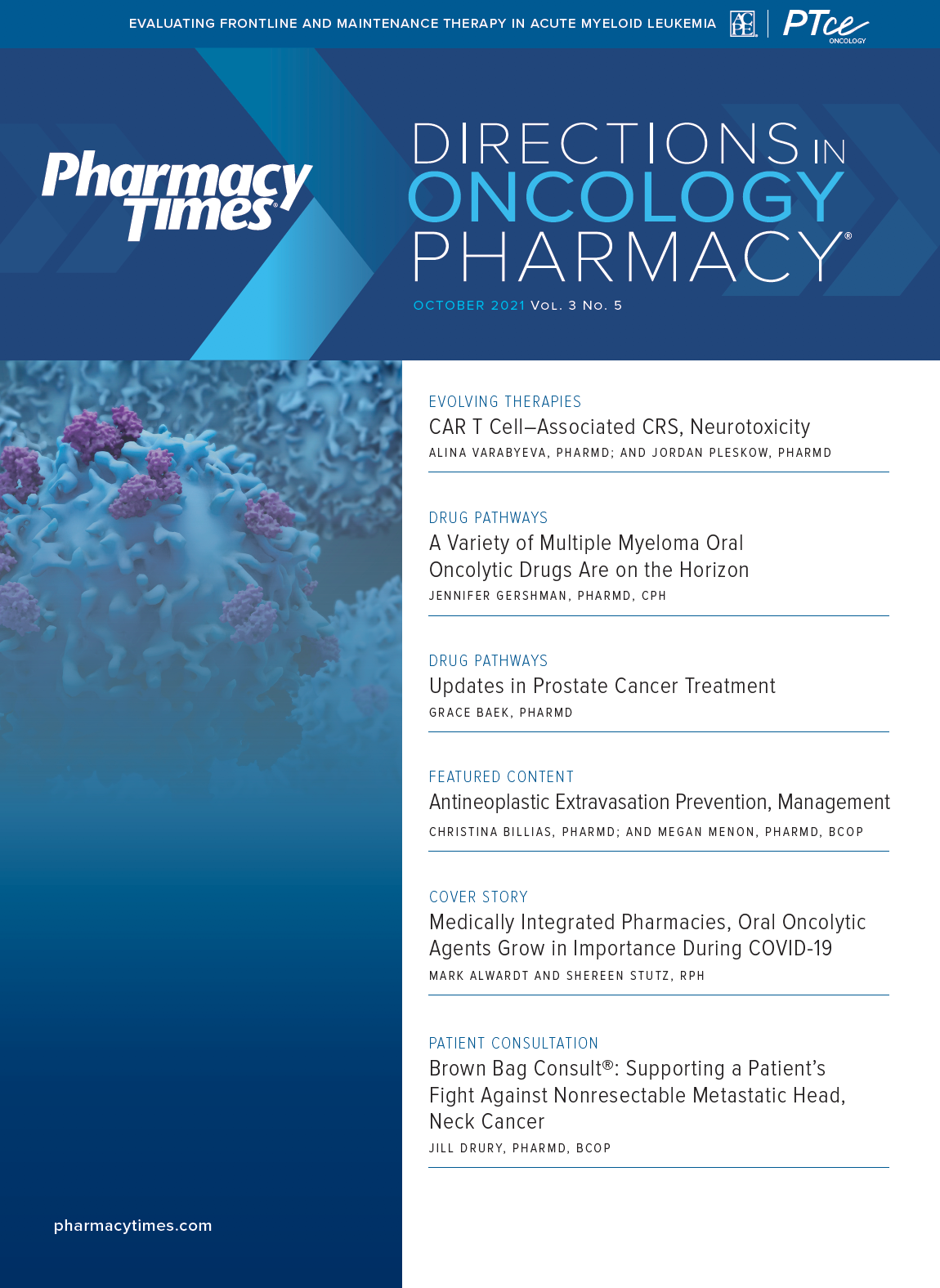Publication
Article
Pharmacy Practice in Focus: Oncology
Multiple Myeloma Treatments, the Pharmacist's Role in Patient Care Evolve
Author(s):
Monitoring for AEs, educating about drug regimens, and managing therapies are opportunities for pharmacists to make a difference.
Multiple myeloma is a cancer of plasma cells that is associated with low blood counts (eg, anemia, thrombocytopenia, and leukopenia), bone and calcium problems, infections, and renal dysfunction. According to the American Cancer Society, over 34,000 new multiple myeloma cases will be diagnosed and approximately 12,000 deaths are expected to occur in 2021.1
Chimeric antigen receptor (CAR) T-cell therapy is an innovative treatment option for multiple myeloma, but these medications can be associated with serious adverse events (AEs).2 Pharmacists can play an integral role as part of a multidisciplinary team to treat patients with multiple myeloma.
Multiple Myeloma Treatment Options and New Drug Approvals
Treatment for multiple myeloma generally depends on cancer stage. For example, solitary plasmacytoma is a rare disorder similar to multiple myeloma that is typically treated with radiation therapy.2 Additionally, chemotherapy is used if multiple myeloma develops.
Patients with smoldering multiple myeloma generally do not require treatment in the early stages. Evidence suggests that treating patients with smoldering multiple myeloma with lenalidomide (Revlimid; Bristol Myers Squibb) and dexamethasone before symptoms develop can prolong survival.2
CAR T-cell Therapy
Active (symptomatic) myeloma patients are typically treated with combination therapy consisting of 2 to 3 medications. CAR T-cell therapy is a type of immunotherapy that assists the body’s immune system in locating and attacking cancer cells. Idecabtagene vicleucel (Abecma; Bristol-Myers Squibb) is a CAR T-cell therapy that targets the B-cell maturation antigen protein; it received FDA approval on March 26, 2021.
The FDA approval of idecabtagene vicleucel was based on a multicenter study that showed 72% of patients partially or completely responded to treatment.3,4 Idecabtagene vicleucel is the first cell-based gene therapy to treat adult patients with relapsed or refractory multiple myeloma after at least 4 different types of treatment.3
Idecabtagene vicleucel is administered as a single-dose intravenous (IV) infusion, and patients should receive premedication with acetaminophen and diphenhydramine 30 to 60 minutes before the infusion.4 Additionally, it carries a boxed warning for cytokine release syndrome (CRS), neurologic toxicities, and hemophagocytic lymphohistiocytosis/macrophage activation syndrome, which can be fatal.4
Idecabtagene vicleucel is only available through a restricted program under a Risk Evaluation and Mitigation Strategy (REMS) because of the risk of CRS and neurologic toxicities.4 Possible signs of CRS include fever, hypotension, tachycardia, chills, headache, fatigue, and low oxygen in the blood.4
Chemotherapy
Chemotherapy was once part of the main treatment for multiple myeloma, but it is now used less often because newer medications have become available.2 Examples of chemotherapy include cyclophosphamide (Cytoxan) and doxorubicin (Adriamycin).
Melphalan flufenamide (Pepaxto) was approved by the FDA on February 26, 2021, in combination with dexamethasone to treat adult patients with relapsed or refractory multiple myeloma.5 However, the postmarketing phase 3 OCEAN trial (NCT03151811) revealed an increased risk of death in patients receiving melphalan flufenamide.6,7
Additionally, the FDA required that the manufacturer suspend enrollment in the OCEAN trial and other ongoing melphalan flufenamide clinical studies.6 Patients who experienced clinical benefits from melphalan flufenamide could continue to receive treatment in the OCEAN trial, but they must be educated about the risks and sign a revised informed consent.6
Any AEs associated with melphalan flufenamide that are observed by pharmacists should be reported to the FDA’s MedWatch AE reporting program.6
Corticosteroids
Corticosteroids such as dexamethasone and prednisone can be used alone or in combination with other medications as part of a treatment regimen for multiple myeloma, and they can help decrease nausea and vomiting from chemotherapy.2 Common AEs associated with corticosteroids include high blood glucose, increased appetite and weight gain, insomnia, and behavioral changes.2
Immunomodulating Agents
These medications include thalidomide (Thalomid), lenalidomide, and pomalidomide (Pomalyst). Lenalidomide and pomalidomide are derivatives of thalidomide, and all the products carry a boxed warning regarding the risk of fetal toxicity and venous and arterial thromboembolism.2 Because of the risks associated with these medications, they are available through REMS.2
Thalidomide was previously used to treat morning sickness in pregnant women but was taken off the market because it was found to cause birth defects. In 2006, thalidomide was approved in combination with dexamethasone for the treatment of patients with newly diagnosed multiple myeloma.2
Proteasome Inhibitors and Histone Deacetylase Inhibitors
Proteasome inhibitors include bortezomib (Velcade), carfilzomib (Kyprolis), and ixazomib (Ninlaro),2 with common AEs such as nausea, vomiting, thrombocytopenia, and diarrhea. Ixazomib is the first and only oral proteasome inhibitor, the form of which may help to improve patient adherence.2
Panobinostat (Farydak) is an oral histone deacetylase (HDAC) inhibitor used in combination with bortezomib and dexamethasone for the treatment of patients with multiple myeloma who have received at least 2 prior regimens that include bortezomib and an immunomodulatory medication.8 Panobinostat carries a boxed warning for severe diarrhea and severe and fatal cardiac ischemic events. Patients should receive antidiarrheal medication at the onset of diarrhea, and panobinostat treatment should be interrupted for moderate diarrhea, occurring at 4 to 6 stools a day.8 Patients should receive an electrocardiogram and have blood work to monitor electrolytes at baseline and during treatment to assess for cardiac abnormalities.8
Monoclonal Antibodies, Antibody-Drug Conjugate, and Nuclear Export Inhibitor
Isatuximab (Sarclisa) is a monoclonal antibody IV infusion that received FDA approval on March 31, 2021 when used in combination with carfilzomib and dexamethasone for patients with relapsed or refractory multiple myeloma who have received 1 to 3 prior different types of therapies.9 Additionally, this marks the second approval for isatuximab for a multiple myeloma indication.9 Common AEs for isatuximab include respiratory tract infections, infusion-related reactions, fatigue, hypertension, diarrhea, pneumonia, shortness of breath, bronchitis, and cough.
Other monoclonal antibody treatment options available include daratumumab (Darzalex; Janssen Biotech) and elotuzumab (Empliciti; Bristol Myers Squibb). Additionally, belantamab mafodotin-blmf (Blenrep; GlaxoSmithKline) is an antibody-drug conjugate,2 whereas selinexor (Xpovio; Karyopharm Therapeutics) is an oral nuclear export inhibitor that works by blocking the XP01 protein.2
Pharmacist's Role in Treating Patients With Multiple Myeloma
Pharmacists can play an integral role as part of an interdisciplinary team to treat patients with multiple myeloma. Monitoring for AEs, educating patients about their drug regimens, and managing supportive therapies are important roles for pharmacists.10
Outcomes for patients with multiple myeloma have improved with novel therapies that include immunomodulatory drugs, proteasome inhibitors, and monoclonal antibodies.10 Supportive care medications, such as oral anticoagulants, calcium and vitamin D supplements, and antivirals, are also typically needed to prevent disease and treatment-related complications, which can increase the pill burden and lead to adherence obstacles.10
Evidence has demonstrated that collaborative pharmacist-physician multiple myeloma clinics can improve medication adherence.10 Pharmacists can provide medication therapy management services that include drug administration education, missed dose instructions, drug-drug and drug-food interactions, and necessary laboratory monitoring.10
Additionally, pharmacists can play an active role in ensuring that patients with multiple myeloma receive COVID-19 vaccines. The National Comprehensive Cancer Network recently issued guidance that patients with hematologic malignancies, such as multiple myeloma, should be prioritized to receive a third COVID-19 vaccine dose as immunocompromised patients.11
Jennifer Gershman, PharmD, CPh, is a drug information pharmacist and Pharmacy TImes contributor who resides in South Florida.
REFERENCES
1. Key statistics about multiple myeloma. American Cancer Society. Updated January 12, 2021. Accessed September 1, 2021. https://www.cancer.org/cancer/multiple-myeloma/about/key-statistics.html[RP1]
2. Treating Multiple Myeloma. American Cancer Society. Accessed September 3, 2021. https://www.cancer.org/cancer/multiple-myeloma/treating.html[RP2]
3. FDA approves first cell-based gene therapy for adult patients with multiple myeloma. News release. FDA. March 27, 2021. Accessed September 3, 2021. https://www.fda.gov/news-events/press-announcements/fda-approves-first-cell-based-gene-therapy-adult-patients-multiple-myeloma[RP3]
4. Abecma. Prescribing information. Bristol Myers Squibb; 2021. Accessed September 3, 2021. https://packageinserts.bms.com/pi/pi_abecma.pdf[RP4]
5. Pepaxto. Prescribing information. Oncopeptides; 2021. Accessed September 4, 2021.https://pepaxto.com/docs/pepaxto_pi.pdf[RP5]
6. FDA alerts patients and health care professionals about clinical trial results showing an increased risk of death associated with Pepaxto (melphalan flufenamide). FDA. August 24, 2021. Accessed September 4, 2021. https://www.fda.gov/drugs/drug-safety-and-availability/fda-alerts-patients-and-health-care-professionals-about-clinical-trial-results-showing-increased[RP6]
7. A study of melphalan flufenamide (Melflufen)-dex or pomalidomide-dex for RRMM patients refractory to lenalidomide (OCEAN). ClinicalTrials.gov. Updated August 4, 2021. Accessed September 4, 2021. https://clinicaltrials.gov/ct2/show/NCT03151811[RP7]
8. Farydak. Prescribing information. Secura Bio; 2015. Accessed September 5, 2021.https://farydak.com/assets/pdf/Farydak-SBI-USPI-201909.pdf[RP8]
9. FDA Approves Sarclisa (isatuximab) in combination with carfilzomib and dexamethasone for patients with relapsed or refractory multiple myeloma. News release. Sanofi. March 31, 2021. Accessed September 5, 2021. https://www.sanofi.com/en/media-room/press-releases/2021/2021-03-31-23-15-00-2202919[RP9]
10. Sweiss K, Wirth SM, Sharp L, et al. Collaborative physician-pharmacist-managed multiple myeloma clinic improves guideline adherence and prevents treatment delays. J Oncol Pract. 2018;14(11):e674-e682. doi:10.1200/JOP.18.00085
11. Recommendations of the National Comprehensive Cancer Network COVID-19 Vaccination Advisory Committee. National Comprehensive Cancer Network. Updated August 30, 2021. Accessed September 5, 2021. https://www.nccn.org/docs/default-source/covid-19/2021_covid-19_vaccination_guidance_v4-0.pdf?sfvrsn=b483da2b_70[RP10]

Newsletter
Stay informed on drug updates, treatment guidelines, and pharmacy practice trends—subscribe to Pharmacy Times for weekly clinical insights.






